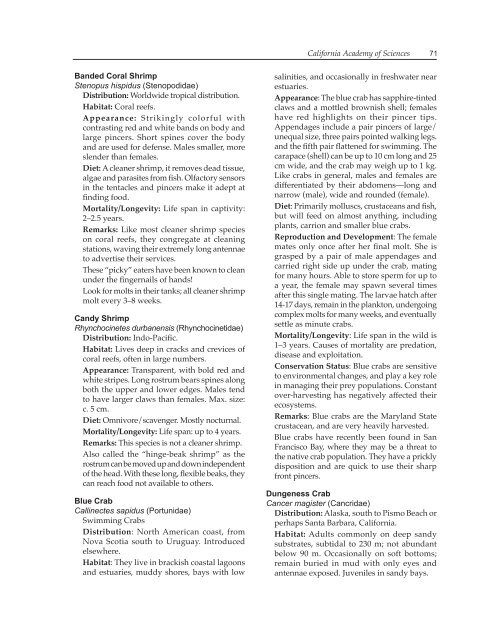THE STEINHART AQUARIUM - Gulf of Guinea Science ...
THE STEINHART AQUARIUM - Gulf of Guinea Science ...
THE STEINHART AQUARIUM - Gulf of Guinea Science ...
You also want an ePaper? Increase the reach of your titles
YUMPU automatically turns print PDFs into web optimized ePapers that Google loves.
Banded Coral Shrimp<br />
Stenopus hispidus (Stenopodidae)<br />
Distribution: Worldwide tropical distribution.<br />
Habitat: Coral reefs.<br />
Appearance: Strikingly colorful with<br />
contrasting red and white bands on body and<br />
large pincers. Short spines cover the body<br />
and are used for defense. Males smaller, more<br />
slender than females.<br />
Diet: A cleaner shrimp, it removes dead tissue,<br />
algae and parasites from fish. Olfactory sensors<br />
in the tentacles and pincers make it adept at<br />
finding food.<br />
Mortality/Longevity: Life span in captivity:<br />
2–2.5 years.<br />
Remarks: Like most cleaner shrimp species<br />
on coral reefs, they congregate at cleaning<br />
stations, waving their extremely long antennae<br />
to advertise their services.<br />
These “picky” eaters have been known to clean<br />
under the fingernails <strong>of</strong> hands!<br />
Look for molts in their tanks; all cleaner shrimp<br />
molt every 3–8 weeks.<br />
Candy Shrimp<br />
Rhynchocinetes durbanensis (Rhynchocinetidae)<br />
Distribution: Indo-Pacific.<br />
Habitat: Lives deep in cracks and crevices <strong>of</strong><br />
coral reefs, <strong>of</strong>ten in large numbers.<br />
Appearance: Transparent, with bold red and<br />
white stripes. Long rostrum bears spines along<br />
both the upper and lower edges. Males tend<br />
to have larger claws than females. Max. size:<br />
c. 5 cm.<br />
Diet: Omnivore/scavenger. Mostly nocturnal.<br />
Mortality/Longevity: Life span: up to 4 years.<br />
Remarks: This species is not a cleaner shrimp.<br />
Also called the “hinge-beak shrimp” as the<br />
rostrum can be moved up and down independent<br />
<strong>of</strong> the head. With these long, flexible beaks, they<br />
can reach food not available to others.<br />
Blue Crab<br />
Callinectes sapidus (Portunidae)<br />
Swimming Crabs<br />
Distribution: North American coast, from<br />
Nova Scotia south to Uruguay. Introduced<br />
elsewhere.<br />
Habitat: They live in brackish coastal lagoons<br />
and estuaries, muddy shores, bays with low<br />
California Academy <strong>of</strong> <strong>Science</strong>s<br />
71<br />
salinities, and occasionally in freshwater near<br />
estuaries.<br />
Appearance: The blue crab has sapphire-tinted<br />
claws and a mottled brownish shell; females<br />
have red highlights on their pincer tips.<br />
Appendages include a pair pincers <strong>of</strong> large/<br />
unequal size, three pairs pointed walking legs.<br />
and the fifth pair flattened for swimming. The<br />
carapace (shell) can be up to 10 cm long and 25<br />
cm wide, and the crab may weigh up to 1 kg.<br />
Like crabs in general, males and females are<br />
differentiated by their abdomens—long and<br />
narrow (male), wide and rounded (female).<br />
Diet: Primarily molluscs, crustaceans and fish,<br />
but will feed on almost anything, including<br />
plants, carrion and smaller blue crabs.<br />
Reproduction and Development: The female<br />
mates only once after her final molt. She is<br />
grasped by a pair <strong>of</strong> male appendages and<br />
carried right side up under the crab, mating<br />
for many hours. Able to store sperm for up to<br />
a year, the female may spawn several times<br />
after this single mating. The larvae hatch after<br />
14-17 days, remain in the plankton, undergoing<br />
complex molts for many weeks, and eventually<br />
settle as minute crabs.<br />
Mortality/Longevity: Life span in the wild is<br />
1–3 years. Causes <strong>of</strong> mortality are predation,<br />
disease and exploitation.<br />
Conservation Status: Blue crabs are sensitive<br />
to environmental changes, and play a key role<br />
in managing their prey populations. Constant<br />
over-harvesting has negatively affected their<br />
ecosystems.<br />
Remarks: Blue crabs are the Maryland State<br />
crustacean, and are very heavily harvested.<br />
Blue crabs have recently been found in San<br />
Francisco Bay, where they may be a threat to<br />
the native crab population. They have a prickly<br />
disposition and are quick to use their sharp<br />
front pincers.<br />
Dungeness Crab<br />
Cancer magister (Cancridae)<br />
Distribution: Alaska, south to Pismo Beach or<br />
perhaps Santa Barbara, California.<br />
Habitat: Adults commonly on deep sandy<br />
substrates, subtidal to 230 m; not abundant<br />
below 90 m. Occasionally on s<strong>of</strong>t bottoms;<br />
remain buried in mud with only eyes and<br />
antennae exposed. Juveniles in sandy bays.


